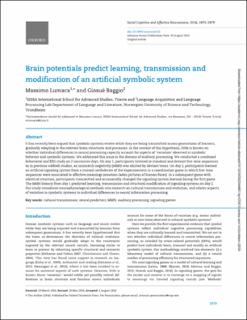| dc.contributor.author | Lumaca, Massimo | |
| dc.contributor.author | Baggio, Giosuè | |
| dc.date.accessioned | 2020-03-25T09:40:53Z | |
| dc.date.available | 2020-03-25T09:40:53Z | |
| dc.date.created | 2016-08-10T18:45:17Z | |
| dc.date.issued | 2016 | |
| dc.identifier.citation | Social Cognitive & Affective Neuroscience. 2016, 11 (12), 1970-1979. | en_US |
| dc.identifier.issn | 1749-5016 | |
| dc.identifier.uri | https://hdl.handle.net/11250/2648502 | |
| dc.description.abstract | It has recently been argued that symbolic systems evolve while they are being transmitted across generations of learners, gradually adapting to the relevant brain structures and processes. In the context of this hypothesis, little is known on whether individual differences in neural processing capacity account for aspects of ‘variation’ observed in symbolic behavior and symbolic systems. We addressed this issue in the domain of auditory processing. We conducted a combined behavioral and EEG study on 2 successive days. On day 1, participants listened to standard and deviant five-tone sequences: as in previous oddball studies, an mismatch negativity (MMN) was elicited by deviant tones. On day 2, participants learned an artificial signaling system from a trained confederate of the experimenters in a coordination game in which five-tone sequences were associated to affective meanings (emotion-laden pictures of human faces). In a subsequent game with identical structure, participants transmitted and occasionally changed the signaling system learned during the first game. The MMN latency from day 1 predicted learning, transmission and structural modification of signaling systems on day 2. Our study introduces neurophysiological methods into research on cultural transmission and evolution, and relates aspects of variation in symbolic systems to individual differences in neural information processing. | en_US |
| dc.language.iso | eng | en_US |
| dc.publisher | Oxford University Press | en_US |
| dc.rights | Navngivelse 4.0 Internasjonal | * |
| dc.rights.uri | http://creativecommons.org/licenses/by/4.0/deed.no | * |
| dc.title | Brain potentials predict learning, transmission and modification of an artificial symbolic system | en_US |
| dc.type | Peer reviewed | en_US |
| dc.type | Journal article | en_US |
| dc.description.version | publishedVersion | en_US |
| dc.source.pagenumber | 1970-1979 | en_US |
| dc.source.volume | 11 | en_US |
| dc.source.journal | Social Cognitive & Affective Neuroscience | en_US |
| dc.source.issue | 12 | en_US |
| dc.identifier.doi | 10.1093/scan/nsw112 | |
| dc.identifier.cristin | 1371983 | |
| dc.description.localcode | © The Author(s) (2016) This is an Open Access article distributed under the terms of the Creative Commons Attribution Non-Commercial License (http://creativecommons.org/licenses/by-nc/4.0/), which permits non-commercial re-use, distribution, and reproduction in any medium, provided the original work is properly cited. For commercial re-use, please contact journals.permissions@oup.com | en_US |
| cristin.ispublished | true | |
| cristin.fulltext | original | |
| cristin.qualitycode | 1 | |

